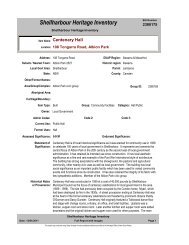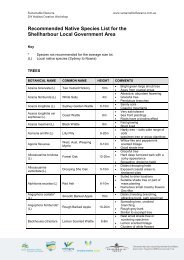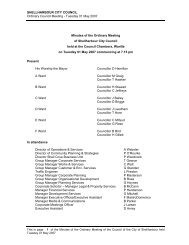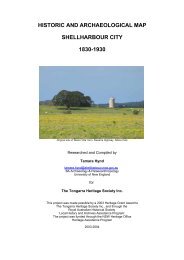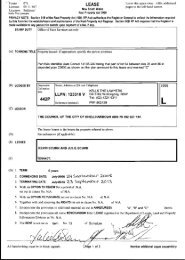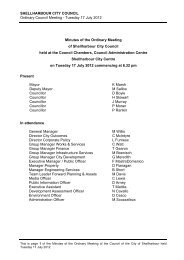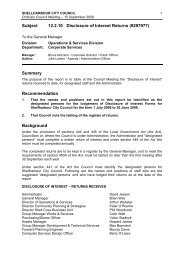WEEDY GRASSES - Shellharbour City Council
WEEDY GRASSES - Shellharbour City Council
WEEDY GRASSES - Shellharbour City Council
Create successful ePaper yourself
Turn your PDF publications into a flip-book with our unique Google optimized e-Paper software.
on the<br />
South Coast<br />
Weedy Grasses<br />
Chilean needle grass<br />
Serrated tussock<br />
Grasses can be some of the most difficult<br />
Cane needle grass<br />
weeds to deal with, largely because of identification<br />
problems. This leaflet covers some of the grass weeds that<br />
are an emerging threat on the South Coast. They are all very<br />
invasive and pose a high risk to the grazing industry and the<br />
natural environment.<br />
Control of weedy grasses is by chipping or spot-spraying of<br />
isolated plants before they produce seed. For large infestations<br />
boom spraying should be considered. For effective long term<br />
control use an integrated program of spraying, sowing and<br />
pasture management.<br />
If using herbicides be sure to read the label and heed the label.<br />
Consult your local <strong>Council</strong> weeds staff or herbicide supplier for<br />
more detailed information about control methods.<br />
Chilean needle grass (Nassella neesiana)<br />
A perennial tussock grass that can grow up to 1 metre high.<br />
The dark green, flat to slightly inrolled leaves are up to 5mm<br />
wide and are sparsely to moderately hairy on both surfaces.<br />
They are usually held parallel to the ground, not erect.<br />
The seed is sharply pointed and enclosed in a membranous<br />
sheath which is red-purple before the seed matures. The seed is<br />
6-10mm long, but has a much longer (45-85mm) awn attached<br />
at the blunt end. The long hairs at the corona provides the best<br />
distinguishing feature between this weed and native spear<br />
grasses (see photo).<br />
The awn twists to drive the seed into the ground, which also<br />
helps the seed to attach to livestock, machinery, vehicles and<br />
clothing. This weed is well established on parts of the Southern<br />
Tablelands and it has spread as road verges have been slashed.<br />
It is not very palatable to stock so can take over from more<br />
palatable grasses in grazed pastures forming a monoculture, as<br />
useful pasture grasses and native vegetation are eaten out.<br />
Chilean needle grass can also produce hidden seed within<br />
the base of the flowering stem. Mowing will be only partially<br />
effective at reducing seed production and is best avoided in<br />
case it spreads seed. Dug out plants should be burnt to destroy<br />
this hidden seed.<br />
Listed as noxious in all coastal Local Government Areas and as<br />
a Weed of National Significance.<br />
Fountain grass<br />
Chilean needle grass<br />
Chilean needle grass seed<br />
Base of long awn<br />
Corona<br />
Native spear grass seed<br />
Comparing seeds<br />
Coolatai grass<br />
White foxtail grass<br />
African feather grass<br />
Spear grasses (Austrostipa species)<br />
Many native spear grasses have similar pointed seeds and a long<br />
awn which becomes curved or kinked as the seed matures. Most<br />
coastal spear grasses have narrower leaves which are inrolled<br />
into a narrow cylinder shape and some have hairy awns.<br />
The most similar is Austrostipa rudis, which is common on the<br />
coast and ranges. The young seed head is virtually identical to<br />
Chilean needle grass, but the mature seed lacks the corona of<br />
hairs at the base of the awn. Its flat leaves are hairy on only one<br />
surface, or much more hairy on one surface than the other.<br />
Many spear grasses have swollen white nodes on the<br />
flowering stems, as does Chilean needle grass, but the<br />
distribution of the white hairs around the nodes<br />
is different (see photo). Chilean needle<br />
grass nodes are only slightly wider<br />
than the rest of the stem.<br />
.<br />
If you see what you thInk may be one of these grasses, or any unfamIlIar grass, Inform your local councIl weeds staff<br />
J Miles<br />
M Ning<br />
Sparse<br />
hairs<br />
Chilean needle<br />
grass node<br />
Giant Parramatta grass<br />
Chilean needle grass in Canberra<br />
Comparing nodes<br />
Native spear<br />
grass node<br />
J Miles
Serrated tussock infestation<br />
Serrated tussock (Nassella trichotoma)<br />
Serrated tussock (Nassella trichotoma) is a long-lived perennial<br />
tussock grass with very fine, rolled leaves which vary from bright<br />
green in the growing season to pale bleached straw colour in winter.<br />
The leaves are held strongly erect, but the flowering stems are weak<br />
and tend to weep over to one side.<br />
The tiny seeds have a long awn and are enclosed in a membranous<br />
sheath which is red before the seed matures, giving the flowering<br />
plant a pink appearance.<br />
Mature seed heads snap off whole and blow around, often<br />
piling up against fences. By this means seed can be spread over<br />
long distances, as well as being carried in or on livestock, on<br />
look-alikes<br />
Hairy panic (Panicum effusum) and blown grass (Lachnagrostis<br />
filiformis, formerly called Agrostis avenacea) have seed heads which<br />
snap off whole and pile up against obstructions. Both have flat leaves<br />
not narrow rolled ones.<br />
Seed head of<br />
Poa meionectes<br />
Some of the Poa species look<br />
quite similar, but their flowering<br />
stems are stiff and erect and remain<br />
on the plant after seed has been<br />
shed. Most often confused with<br />
serrated tussock are river tussock<br />
(Poa labillardierei), a more robust<br />
tussock of dampish areas and Poa<br />
meionectes, a small forest<br />
grass with very fine bright green leaves. Poa seed is not awned and<br />
often has a purple tinge, not red or pink.<br />
Native river<br />
tussock<br />
Comparing tussocks<br />
Weedy serrated<br />
tussock. Note the much<br />
finer, brighter green<br />
leaves.<br />
Seed head of<br />
serrated tussock<br />
vehicles which have driven through infested areas and in soil and<br />
contaminated hay or other stock feed.<br />
Serrated tussock is a common weed on the tablelands, but is less<br />
well established on the south coast. However, there are pockets of<br />
infestation, from the Towamba Valley in Bega Valley Shire to the upper<br />
Shoalhaven catchment.<br />
It is not palatable to stock and has almost no nutritional value.<br />
Especially in grazed pastures, it can form a monoculture, displacing<br />
useful pasture grasses and native vegetation. It is listed as noxious<br />
throughout NSW and as a Weed of National Significance.<br />
Weedy serrated<br />
tusock<br />
ligule visible<br />
A useful feature for distinguishing<br />
serrated tussock from Poa species<br />
is its ligule, an erect membranous<br />
white flap found where the leaf<br />
blade joins the leaf sheath. Pulling<br />
the leaf blade away from the stem<br />
will reveal the ligule on serrated<br />
tussock. Local Poa species have<br />
a ligule but it is very short and not<br />
visible to the naked eye.<br />
Some native speargrasses (Austrostipa species) have similar erect, very<br />
narrow leaves and awned seed which can appear pink in the flowering<br />
stage. Corkscrew grass (Austrostipa scabra) is the most similar, but its<br />
seed is much larger and more elongated and stems are more upright<br />
and remain on the plant after seed is shed. It is more likely to be found<br />
on the tablelands, but does occur in some parts of the south coast.<br />
Corkscrew grass<br />
Seed heads snap off whole and blow around<br />
River tussock<br />
Comparing ligule<br />
Serrated<br />
tussock<br />
Comparing seed<br />
Corkscrew<br />
grass
Weedy grass commonly appear first on roadsides<br />
African feather grass<br />
African feather grass (Pennisetum<br />
macrourum) has been grown as an<br />
ornamental grass and is occasionally<br />
naturalised on the south coast. It is a<br />
very robust tussock with bright green<br />
raspy-textured flat leaves up to 12mm<br />
wide. The seed head is a narrowly<br />
cylindrical bristly spike 8-30cm long.<br />
weedy look-alikes<br />
Fountain grass (Pennisetum setaceum) is a commonly grown<br />
ornamental which also sometimes becomes naturalised near<br />
towns and gardens, and the very similar native swamp foxtail (P.<br />
alopecuroides) is also sometimes grown. Both have purple bristly<br />
flowering spikes, slightly longer and narrower in fountain grass.<br />
Feathertop or white foxtail (P. villosum) has fluffy white seed heads.<br />
It is an uncommon weed on the<br />
coast. It is not listed as noxious but<br />
can be quite invasive. It is a much<br />
smaller plant generally only about<br />
30cm high and tending to form<br />
spreading clumps.<br />
Swamp foxtail<br />
Old seed head, many<br />
seeds are shed.<br />
White foxtail grass<br />
Fountain grass<br />
Flowering stems with<br />
long lower branches<br />
Giant Parramatta<br />
grass<br />
Giant Parramatta grass<br />
Giant Parramatta grass (Sporobolus fertilis) belongs to the rat’s<br />
tail grass group, most of which look similar and are hard to tell<br />
apart. Some are native, some weedy and some listed as noxious<br />
weeds. Parramatta grass (Sporobolus africanus) is an extremely<br />
common weed to 90cm high but usually shorter, growing in<br />
degraded pasture, sandy soils and compacted soil such as on<br />
tracks. Giant Parramatta grass is similar but larger, to 1.6m high. It<br />
has tough wiry stems, green to blue-green hairless leaves and a<br />
long, narrow flowering spike composed of many tiny leaden grey<br />
florets. It differs from Parramatta grass in having long (8-11cm)<br />
branches in the lower part of the flowering spike, which droop<br />
away from the stem. In Parramatta grass there may be some<br />
branches at the base of the flowering spike, but they are short<br />
and do not droop.<br />
Giant Parramatta grass is mainly a weed of moister environments<br />
and is a nuisance in pastures on the NSW north coast. Isolated<br />
occurrences have been found on the south coast and it is listed as<br />
noxious in all south coast local government areas. It has little feed<br />
value and can dominate pasture and replace native plants in wet areas.<br />
Seed becomes sticky when wet and readily adheres to animals,<br />
clothing and vehicles. First arrival in an area is usually along track<br />
edges.<br />
Giant rat’s tail grass (S. pyramidalis) is another noxious weed,<br />
similar but with long branches which open out at maturity to form a<br />
pyramidal seed head. It has been recorded at Milton.<br />
look-alikes<br />
Native rat’s tail<br />
grasses (Sporobolus<br />
elongatus and S. creber)<br />
are similar. They are<br />
shown here with the<br />
shorter, denser spike<br />
of Parramatta grass<br />
on the left. Both have<br />
gaps at the base of<br />
the flowering spike<br />
where the stem shows<br />
through, S. creber with<br />
very large gaps.<br />
Parramatta<br />
grass<br />
Native rat’s<br />
tail grasses<br />
Comparing grass heads Comparing flowering spikes<br />
Parramatta grass
weedy plants:<br />
a threat to agriculture<br />
and the environment<br />
Coolatai grass (Hyparrhenia hirta)<br />
A perennial tussock grass to 1 metre high. It has flat blue-green<br />
leaves and a two branched seedhead. Each floret is covered in<br />
silky hairs which fluff up when the seed is ripe (above right).<br />
The flowering stems are reddish, and as sections of bare stem<br />
are separated by green leaf sheaths they give the impression of<br />
being composed of broad red and green bands. Unfortunately<br />
several common native grasses also look like this.<br />
Coolatai grass is spreading rapidly on road verges around the<br />
state, mostly on the slopes, but it has become established on<br />
the outskirts of Sydney and is moving into the Illawarra. A single<br />
roadside infestation has been found in the Bega Valley.<br />
Some native tussock grasses<br />
Common natives such as kangaroo grass (Themeda australis), barbedwire<br />
grass (Cymbopogon refractus) and red-leg grass (Bothriochloa<br />
macra) all share the tussocky growth habit. They have broad flat<br />
leaves which may be blue-green similar to Coolatai grass.<br />
Above: Barbed-wire grass has the<br />
florets arranged in short spikes<br />
which are similar to the barbs on<br />
barbed wire in shape. Coolatai<br />
grass is at right.<br />
Inset: Barbed-wire grass showing<br />
the two-colour effect on the stems.<br />
Coolatai grass two<br />
branched seed head<br />
Coolatai grass tussock Coolatai grass on road verge near Berry<br />
Native barbed-wire grass<br />
Comparing grasses<br />
Weedy Coolatai grass<br />
Barbed-wire grass stem<br />
J Miles<br />
J Miles<br />
Cane needle grass (Nassella hyalina)<br />
Another emerging weed, which has been found at one site<br />
in the Bega Valley. It is similar to Chilean needle grass, but has<br />
shorter awns on the seed (35-40mm). Its corona is about the<br />
same length with sparser hairs.<br />
The common name is misleading, as the plant is just an<br />
ordinary tussock with leaves 1.5-4mm wide,flat or rolled.<br />
There are two native plants which have a bamboo-like<br />
appearance, and could be mistaken for this weed, just on the<br />
basis of the name. They are Austrostipa ramosissima, common<br />
round the edges of wet gullies on the coast, and Austrostipa<br />
verticillata, which grows in dense patches under trees in the<br />
Bega Valley, particularly in the Candelo area.<br />
Below: Red-leg grass has hairy spikes of florets very similar to<br />
Coolatai grass, but they are in groups of 3-6,<br />
not paired (green at left, ripe on right).<br />
Red-leg grass<br />
for more information please contact:<br />
Illawarra District Noxious<br />
Weeds Authority (02) 4233 1129<br />
Shoalhaven <strong>City</strong> <strong>Council</strong> (02) 4429 3111<br />
Eurobodalla Shire <strong>Council</strong> (02) 4474 1000<br />
Bega Valley Shire <strong>Council</strong> (02) 6499 2222<br />
Inset: Kangaroo grass has<br />
distinctive drooping seed<br />
heads, with a long, dark awn<br />
on each seed. All of these<br />
native grasses can look similar<br />
to Coolatai grass, especially<br />
when growing en masse.<br />
Cane needle grass seed<br />
Kangaroo grass<br />
Corona<br />
written by J Miles • artwork by ECI Insitu Pty Ltd • printed by Excell Printing on Australian made 100% recycled paper<br />
M Moerkerk DPI Vic<br />
J Miles



